Articles of 2010
The Last Great Heavyweight Rivalry, Part 1: Ali-Frazier
Editor's Note: Last month TSS columnist George Kimball was invited to participate, along with two-time heavyweight champion George Foreman and Dr. Robert Rodriguez , in a Boxing Symposium at the University of Kansas. Entitled “The Last Great Heavyweight Rivalry,” Kimball's presentation at the KU event anecdotally compared the 1970s heavyweight nexus of Muhammad Ali, Joe Frazier, George Foreman, and Ken Norton with that of the middleweight rivalry celebrated in his acclaimed book FOUR KINGS: Leonard, Hagler, Hearns, Duran and the Last Great Era of Boxing. That lecture formed the basis for a special TSS series commencing with this installment.
My book FOUR KINGS recounted the historic rivalry between Sugar Ray Leonard, Marvelous Marvin Hagler, Thomas Hearns, and Roberto Duran. Between 1980 and 1989, those four men engaged in nine fights between them. Each of them beat at least one of the others, and each of them lost to at least one of the others.
While the era of the Four Kings was a watershed moment in boxing history, it was not entirely unique. A remarkable parallel existed between four great heavyweights just ten years earlier. Like my middleweight Four Kings, each member of this quartet — Muhammad Ali, Joe Frazier, George Foreman and Ken Norton — beat at least one of the others and lost to at least one of the others. These heavyweights engaged in ten fights against one another, and in an even briefer — six years in all — time frame than my middleweights of a decade later.
Yes, I described that of the Four Kings as “the last great era of boxing.” But I never claimed it was the only one.
The principal difference between them was that while Leonard-Hagler-Hearns-Duran was a proper round-robin, Joe Frazier and Ken Norton never fought each other. The principal reason for this was that both men were trained by the late Eddie Futch, a highly principled man who would have been extremely reluctant to match them against one another. (When Larry Holmes and Michael Spinks fought for the first time in 1985, Futch elected to watch from the sidelines rather than take sides. Spink understood this decision, but Holmes was critical. When the two met in a rematch the next year, Eddie was in Spinks' winning corner.) Futch, in fact, played an important role in these proceedings — that of the demystifier of Muhammad Ali. As my old friend pointed out to me on a number of occasions, “In his whole career Ali only lost to five guys — and I had three of 'em.”
The basis for this great heavyweight rivalry would have been apparent to no one in 1964 when Cassius Clay, as he had predicted that he would, “shook up the world” by upsetting the fearsome Charles (Sonny) Liston. When Liston failed to answer the bell for the seventh round in Miami Beach, Clay, who had gone into the fight a 7-1 underdog, assumed a place in boxing history as the legitimate heir to Jack Johnson, Jack Dempsey, Joe Louis, and Rocky Marciano.
On the night of February 25, 1964, Joseph William Frazier was an amateur heavyweight who still answered to the name “Billy.” Billy Frazier had just celebrated his 20th birthday, and was still hoping to land a berth on the Olympic team the United States would send to Tokyo. Down in Houston, a juvenile delinquent named George Foreman had just turned 15, and appeared destined for a life of crime. Ken Norton was a 20 year-old Marine Corps Lance Corporal, stationed at Camp Pendleton, California.
In the first list of worldwide rankings to emerge after Clay's defeat of Liston, the world's Top Ten heavyweight contenders were, in order, (1) Liston, (2) Floyd Patterson, (3) Ernie Terrell, (4) Cleveland Williams, (5) George Chuvalo, (6) Zora Folley, (7) Karl Mildenberger, (8) Roger Rischer, (9) Eddie Machen, and (10) Doug Jones.
At the time he won the title, Clay had faced only one of these. A year earlier, in 1963, he had won a disputed decision over Jones at Madison Square Garden. But beginning with his 1965 rematch against Liston, over the next three years the new champion took on Numbers One through Seven on the aforementioned list of contenders and defeated them all, five inside the distance. Only Chuvalo and Terrell survived to hear the final bell.
(The two he didn't fight? Rischer, ranked eighth in 1964, quickly took himself off the list when he suffered back-to-back losses to Thad Spencer and Brian London the next year. The 30 year-old Machen's fall was even more dramatic. Of the five fights in which he engaged beginning in July of 1964 he lost four, drew the other, and had ceased to be a contender in anyone's mind.) Cassius Marcellus Clay Jr. had seemed a breath of fresh air. Handsome, engaging, and youthfully exuberant, the youngster from Louisville, Ky. had returned from the 1960 Rome Olympics with the light-heavyweight gold medal, and was soon making the rounds of the popular television talk shows of the day.
A consortium of well-heeled Louisville businessmen had banded together to underwrite Clay's professional career. They in turn made the decision to pack him off to Miami Beach, where the respected trainer Angelo Dundee had set up shop in a gym owned in conjunction with his older brother, promoter Chris Dundee.
Although his status today is that of an iconic and almost mythical American hero, it should be noted that Clay was not universally beloved — and that in short order he would come to be roundly despised by many of his countrymen. Although his professional trajectory was impressive from the outset, Clay had already begun to dissipate some of the residual good will from the Olympics with his penchant for self-promotion. Not long after turning professional, Clay found himself intrigued by the public image the wrestler Gorgeous George had constructed for himself, and made a conscious decision to adopt a similar public personality.
Increasingly wont to describing himself as “the greatest,” Clay took to taunting prospective opponents, gibes which were often expressed in rudimentary poetry. He sported brightly colored satin robes and trunks, wore tasseled shoes, and in the ring often seemed more flash than dash.
Although the term “trash-talking” had yet to gain currency, Clay was an early proponent and, eventually, master of that medium, and in an age in which boxers were expected to respect their opponents, his boastful style did not sit well with many American sporting fans — particularly those of the Caucasian persuasion, many of whom had come to regard his posture as that of the prototypical “uppity nigger.”
By the time Clay was scheduled to meet Liston in Miami Beach, for every white American who found his antics refreshing there were three more openly rooting for Liston to put him in his place. And in the days immediately preceding the fight, another factor emerged that would profoundly influence the way he was perceived. Reports that he had increasingly become involved with the Nation of Islam and its mysterious leader, Elijah Muhammad, seemed to have been confirmed when he was spotted in the company of the man then considered to be Elijah's consigliore, Malcolm X. Although Dundee and publicist Harold Conrad worked out a behind-the-scenes deal and persuaded Malcolm to get out of town until the night of the fight, the rumors continued to swirl. The morning after he defeated Liston, Clay confirmed his Muslim affiliation, and announced that he was renouncing what he described as his “slave name.”
Henceforth he would be known as….
Cassius X.
(The name Muhammad Ali would come later, and was personally conferred on him by Elijah Muhammad.)
Usually described by the mainstream media as “the Black Muslims,” the Nation and its separatist policies were considered a major threat to the integrationist goals of the fledgling Civil Rights movement. Both white liberals and black progressives distanced themselves from Clay/Ali as a result.
An ironic development was the Elijah-Malcolm schism that developed shortly after the first Liston fight. Malcolm X came to embrace a more traditionally orthodox interpretation of Islam, rejecting some of the more bizarre accoutrements of Elijah's personally-contrived theology. Although Malcolm's universalist view was very much in keeping with the Sunni/Sufi teachings Ali would himself eventually practice, at the time his allegiance remained with Elijah Muhammad, and following Malcolm's assassination there were genuine fears that Ali would be a target of retribution by Malcolm's followers.
Ali had already earned the enmity of tradition-minded fans and disaffected liberals alike, but in short order he would become the most despised sporting figure in America when he came down on what was at the time considered the “wrong” side of the most polarizing issue of the day — the Vietnam War.
When he was reclassified 1-A in early 1966, making him eligible for the draft, Ali almost immediately signaled his unwillingness to participate as a matter of conscience.
“I ain't got nothing against them Viet Congs,” he famously said, and on another occasion he pointed out that “no Viet Cong ever called me 'nigger.'”
On April 28, 1967, Ali reported to the induction center in Houston, but declined three commands to take the ceremonial step forward that would have confirmed his willingness to be drafted. Within a matter of hours his boxing license had been revoked by the New York State Athletic Commission, and other governing bodies rapidly followed suit. Even though he would not stand trial on the draft evasion charge until June, by nightfall most jurisdictions had already withdrawn recognition of his heavyweight championship.
Even while preparing himself for a prison stretch he considered a virtual certainty (his five-year sentence was stayed pending the resolution of his appeal), Ali had staged a scorched-earth campaign through the heavyweight division in which he had eliminated virtually every credible challenger, and by any reasonable definition would have been approaching the prime of his career.
Even though his great rivalries were yet to come, Muhammad Ali's career never had a “prime.” He had just turned 25 when he was prevented from earning a living for more than three and a half years.
As much as this injustice might be deplored today, Ali's banishment was widely applauded at the time. Most of mainstream America, in fact, wondered how he could be speaking on college campuses and walking alongside Martin Luther King in antiwar marches instead of being where he belonged — behind bars.
Many sportswriters shared that view, although a number writers and intellectuals did support Ali's position — on the due process issue, if not on the war itself. More typical was the reaction of Ali's predecessor Floyd Patterson, who in an Esquire story ghost-written by Gay Talese* and amusingly entitled “In Defense of Cassius Clay,” claimed that “right now the only people in America who are not booing him are the Black Muslims,” and offered as his solution: “I do not see how Clay can get himself out of the mess he got himself into unless he quits the Muslims.”
In expressing the latter viewpoint Patterson and Talese were guilty of trivializing Ali's religious commitment. In the other, they had essentially dismissed the swelling tide that would shortly sweep its way across America — the anti-war movement, to which the bravery of Muhammad Ali's stance had made him nothing less than a hero. It would be October of 1970 before Ali boxed again. Georgia was not regulated by an officially recognized boxing commission, and supporters were able to cut through the red tape and clear the way for him to fight Jerry Quarry in Atlanta. (The fight lasted less than three rounds and ended with Quarry, not for the first time, cut to ribbons.)
On June 28, 1971, the United States Supreme Court, in a unanimous 8-0 decision, overturned Ali's conviction on the draft evasion charge. Shortly thereafter the New York State Supreme Court ruled that he had been unfairly deprived of his boxing license, clearing the way for a return to Madison Square Garden, where, that December, he knocked down Oscar Bonavena (who had given Joe Frazier his two toughest fights) three times in the 15th round for a TKO win. This in turn set the stage for what was widely described as the “Fight of the Century” between Ali and Frazier at the Mecca of Boxing the following March.
Frazier was the son of a South Carolina sharecropper who had moved north to Philadelphia. There, he had worked in a slaughterhouse, where he originated a technique — pounding away at frozen slabs of beef — that would later be given widespread currency by another Philadelphia heavyweight named Rocky Balboa.
Frazier had retained his amateur status through the 1964 Tokyo Games, in which he hoped to represent the United States. His dream appeared to have been dashed when he lost in the Olympic Trials to Buster Mathis. When Mathis broke a hand in training, he was replaced by the first alternate, Frazier, who then proceeded to win all of his bouts and return with the Gold Medal. Frazier had not yet made his pro debut when he visited Ali at his New England training camp, where he was preparing for his rematch against Liston. There, the youngster asked the champion if he had any advice for him.
“Yeah,” joked Ali. “Lose some weight and become a light-heavyweight.”
Ali-Frazier matched two undefeated champions, each of whom could legitimately claim that designation. Ali referred to himself as “the people's champion,” and pointed out, correctly, that he had never lost his title in the ring. On the other hand, he had officially “resigned” his title to confer legitimacy on the winner of the 8-man tournament the WBA conducted to determine his successor — who turned out to be his boyhood friend and sometime sparring partner, Jimmy Ellis. Frazier, on the recommendation of Eddie Futch, had declined to participate in the WBA exercise. Instead, in March of 1968 he was matched against his old amateur foe Mathis at Madison Square Garden for what was recognized as the “world” heavyweight championship by the New York commission, along with the governing bodies of four other states — Massachusetts, Pennsylvania, Pennsylvania, and Illinois. He had defended NYSAC version four times when he was matched against Ellis for what was billed as the “undisputed” championship. In New York in March of 1970, Frazier won on a 5th-round TKO, and then in November, a month before Ali fought Bonavena, knocked out light-heavyweight champion Bob Foster in Detroit. The win brought Frazier's record to 26-0 on the night of their epic encounter. Ali was 31-0, but he was fighting for just the third time in five years.
As much event as boxing match, Frazier-Ali I was unlike any heavyweight championship fight before or since. A Hollywood producer named Jerry Perenchio, having ponied up five million dollars in guarantees to bypass boxing's traditional power structure, was the promoter of record, and it shortly became apparent that Frazier-Ali would be catered to Perenchio's constituency, an audience in which A-list celebrities outnumbered hard-core boxing fans. It was a night, said Bobby Goodman, for “plumage, pimps, and hustlers.”
The nation's two top blow-by-blow announcers, Don Dunphy and Howard Cosell, had so desperately coveted the assignment behind the microphone that night that either would have gladly done it for free. Each monitored the other in the run-up to the fight, fearful that his rival might outmaneuver him to gain Perenchio's ear. One day Dunphy's son, an ABC assistant director, phoned his father to report a stunning piece of news.
“I'm not going to do the Ali-Frazier fight, and neither is your father,” Cosell told Don Jr. “They're going to use Andy Williams, Kirk Douglas, and Burt Lancaster.”
That had in fact been Perenchio's plan, but, happily, cooler heads eventually prevailed, and by fight night only the Birdman of Alcatraz remained on the broadcast team. Dunphy was the lead announcer, with Archie Moore joining him and Lancaster at ringside.
As he looked down from Frazier's corner that night, Eddie Futch recalled “a sea of glitter.” As he climbed the steps to Ali's corner across the ring, Angelo Dundee heard someone call his name. He turned in response, just in time to have his picture snapped by Life Magazine's photographer at ringside — a fellow named Sinatra.
“There had never been a night like this one in New York City,” Bill Nack would recall in a Sports Illustrated piece a quarter-century later. “By 10:30 pm on the evening of March 8, 1971, when the two fighters climbed into the ring at Madison Square Garden, Ali in red trunks and Frazier in green-and-gold brocade, there was a feral scent and crackle to the place. The Garden was a giant bell jar into which more than 20,000 people had drifted, having passed through police barricades that rimmed the surrounding streets. They came in orange and mint-green and purple velvet hot pants, in black leather knickers and mink and leopard capes, in cartridge belts and feathered chapeaux and pear-gray fedoras. Some sported hats with nine-inch brims and leaned jauntily on diamond-studded walking sticks. Manhattan listed toward Babylon.”
Although he was able to battle on fairly even terms over the first ten rounds, it was clear for most of the night that three rounds with Quarry and 15 with Bonavena had not been enough to clear the accumulated ring rust from his protracted, though involuntary, layoff. When Frazier began to pour it on over the final few stanzas, Ali needed one of his old miracles to turn the tide, but he reflexes, the timing, and ultimately, the stamina that had characterized his first career were absent on this night.
Only the ring ropes had kept Ali on his feet when he was crushed by a Frazier left late in the eleventh, and Ali's jaw had swollen to grotesque proportions even before Frazier decked him with the left hook that put the fight out of reach.
When the scorecards were tallied, one judge, Bill Recht, had scored just four of the 15 rounds for Ali. The other, Artie Aidala, had it 9-6 for Frazier, while referee Arthur Mercante had Frazier the winner, 8-6-1.
In handing Muhammad Ali his first professional defeat, Joe Frazier had drawn first blood in what would become a four-way rivalry for the ages. Ali, Frazier, George Foreman, and Ken Norton wound engage in nine more of these encounters over the next five years, and Joe Frazier would be a participant in four more of them. He could not have known it at the time, but within the confines of this select company, Frazier would never win another.
* * *
*—EDITOR NOTE: Nan Talese, the wife of writer Gay Talese, told us her husband didn't ghost write the piece. Writer Kimball points out that the copyright acknowledgements for David Remnick's KING OF THE WORLD not only attribute “In Defense of Cassius Clay” to Talese but list him as the copyright holder. Of course, TSS defers to the word of Mrs. Talese on this matter. And maybe on another day, we'll get to the bottom of this mini mystery.
-

 Featured Articles4 weeks ago
Featured Articles4 weeks agoAvila Perspective, Chap. 330: Matchroom in New York plus the Latest on Canelo-Crawford
-
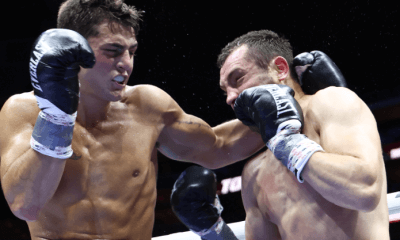
 Featured Articles3 weeks ago
Featured Articles3 weeks agoVito Mielnicki Jr Whitewashes Kamil Gardzielik Before the Home Folks in Newark
-
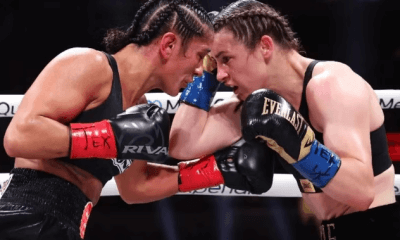
 Featured Articles7 hours ago
Featured Articles7 hours agoResults and Recaps from New York Where Taylor Edged Serrano Once Again
-
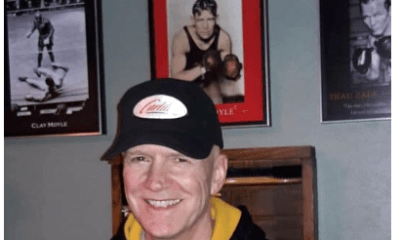
 Featured Articles4 weeks ago
Featured Articles4 weeks agoCatching Up with Clay Moyle Who Talks About His Massive Collection of Boxing Books
-
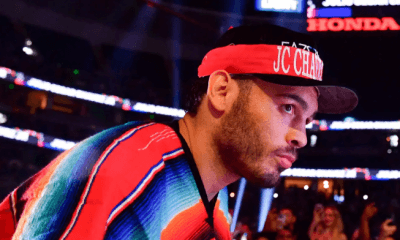
 Featured Articles5 days ago
Featured Articles5 days agoFrom a Sympathetic Figure to a Pariah: The Travails of Julio Cesar Chavez Jr
-
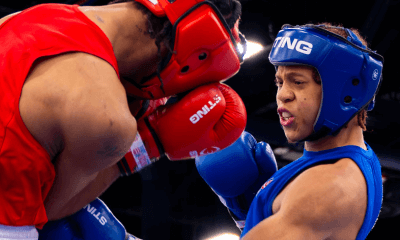
 Featured Articles3 weeks ago
Featured Articles3 weeks agoMore Medals for Hawaii’s Patricio Family at the USA Boxing Summer Festival
-
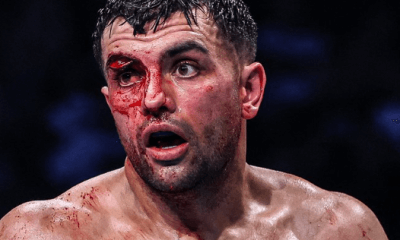
 Featured Articles7 days ago
Featured Articles7 days agoCatterall vs Eubank Ends Prematurely; Catterall Wins a Technical Decision
-
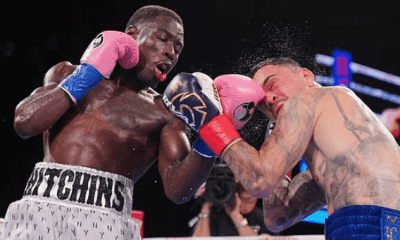
 Featured Articles4 weeks ago
Featured Articles4 weeks agoRichardson Hitchins Batters and Stops George Kambosos at Madison Square Garden

















